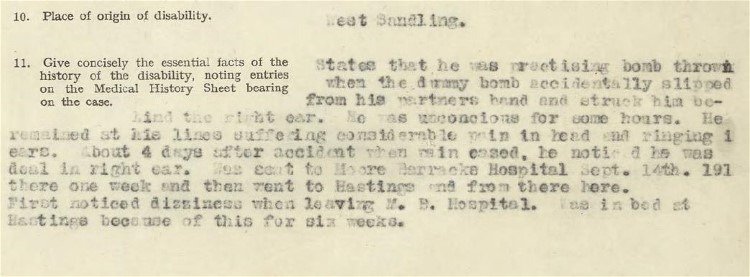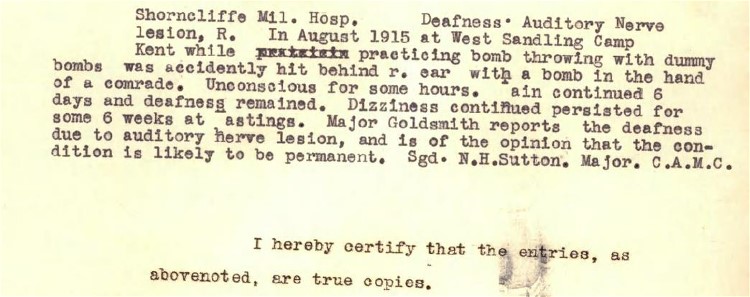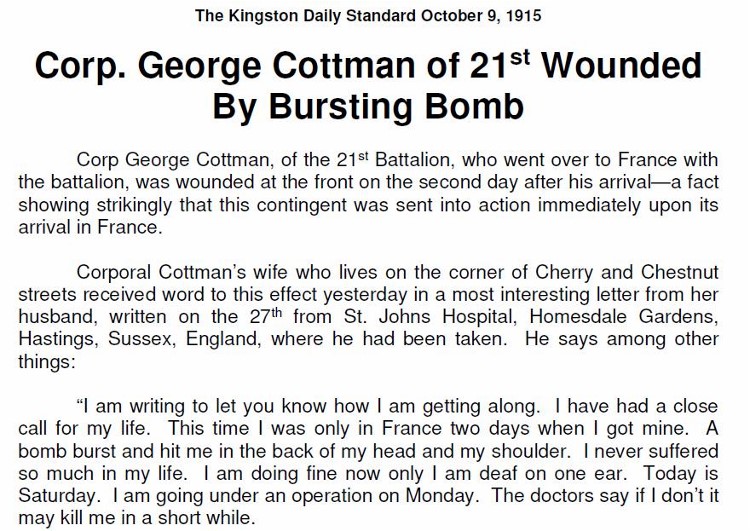|
Nov 25, 1878
|
Born in Gananoque,
Ontario to George Washington and Rachel (nee Forder) Cottman
|
|
Jul 4, 1898
|
Married to Mary
Elizabeth “Minnie” Ward
|
|
May 7, 1901
|
Volunteered in the
14th Regiment PWOR (Princess of Wales’
Own Rifles)
Ø
Number 150
Ø
Assigned to
“C” Company
Ø
Occupation shown
as Boilermaker
All of his PWOR
records show his surname as Cotman, not Cottman
|
|
Oct 4, 1901
|
Discharged from
the PWOR
|
|
Jun 3, 1902
|
Volunteered in the
14th Regiment PWOR
Ø
Number 350
Ø
Assigned to
“C” Company
Ø
Occupation shown
as Boilermaker
|
|
Oct 28, 1902
|
Discharged from
the PWOR
|
|
Jun 15, 1904
|
Volunteered in the
14th Regiment PWOR
Ø
Number 588
Ø
Assigned to
“F” Company
Ø
Occupation shown
as Boilermaker
Ø
Address shown as 5
Cherry St., Kingston
|
|
Jun 6, 1910
|
Discharged from
the PWOR
|
|
Jan 6, 1915
|
Shown on the
payroll of the 8th CMR (Canadian Mounted Rifles)
after volunteering with the 4th Hussars
|
|
Jan 26, 1915
|
Transferred to the
21st Battalion in Kingston
|
|
Jan 27, 1915
|
Attested into the
21st Battalion CEF in Kingston, Ontario
Ø
Number 59203
(temporary number 1223)
Ø
Next of kin given
as Mrs. Mary Elizabeth Cottman, wife, 1 Chestnut St., Kingston, Ontario
Ø
Previous
occupation given as Boilermaker at the Kingston Locomotive Company
Ø
Previous military
experience given as 15 years in 14th PWOR
(Princess of Wales’ Own Rifles)
Ø
Religion given as
Church of England
Ø
Assigned to the
Depot Company
o
Employed as a
Drummer in the battalion’s Bugle Band
The battalion
trained in the Kingston area through the winter with headquarters in
the Kingston Armouries
|
|
May 6, 1915
|
Embarked the RMS
Metagama in Montreal, Quebec

|
|
May 15, 1915
|
Disembarked in
Devonport, England and the battalion proceeded to the West Sandling
Camp, near Hythe, Kent to continue training
|
|
Aug 28, 1915
|
Transferred from
the Depot Company to “B” Company
Rank shown as
Lance Corporal
|
|
Sep 2, 1915
|
Transferred from
“B” Company to “A” Company
|
|
Sep 15, 1915
|
Admitted to the
Moore Barracks Hospital in Epsom with a depressed fracture of the skull
over the right ear that happened during a training exercise when he was
hit by a dummy bomb thrown by a comrade that had rendered him
unconscious for several hours. On
one medical statement the accident is recorded as happening on
September 7 but there are no other medical records or hospital
admissions to confirm this
He was also
suffering from Tonsillitis
|
|
Sep 23, 1915
|
Discharged from
hospital
|
|
Sep 25, 1915
|
Transferred to the
39th Reserve Battalion and employed in the
Orderly Room
|
|
Nov 26, 1915
|
Admitted to the
St. John’s Ambulance Brigade Hospital in Hastings and
Shingles is added to the diagnosis of Skull Fracture
|
|
Dec 17, 1915
|
Transferred to the
Shorncliffe Military Hospital
Medical Board at
Shorncliffe notes:
Ø
Patient suffers
from a fractured skull causing dizziness and headaches
Ø
Patient is deaf in
the right ear as a result of the fracture
Ø
Patient’s
condition is considered permanent and recommends Permanent Base duty
with no marching
|
|
Jan 1, 1916
|
Discharged from
hospital
|
|
Apr 30, 1916
|
Declared to be AWL
(Absent Without Leave)
|
|
May 13, 1916
|
Reported for duty
and forfeited 14 days pay and allowances for his absence and sentenced
to 14 days Field Punishment No. 2
|
|
Jun 21, 1916
|
Transferred to the
COC (Canadian Ordnance Corps) in Ashford and reverted to the rank of
Private at his own request
|
|
Mar 6, 1917
|
Transferred to the
CCAC (Canadian Casualty Assembly Centre) pending return to Canada
|
|
Mar 10, 1917
|
Attached to the
CDD (Canadian Discharge Depot) in Buxton pending return to Canada
|
|
Mar 23, 1917
|
Embarked the SS
Grampian in Liverpool
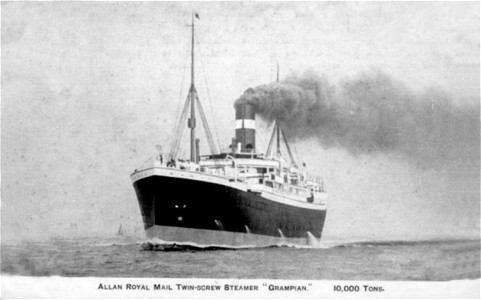
|
|
Apr 9, 1917
|
Disembarked in
Saint John, New Brunswick and proceeded to Quebec City, Quebec for
medical evaluation
|
|
Apr 18, 1917
|
After leaving
Quebec City George Cottman proceeded to Kingston, Ontario where he was
admitted to the Elmhurst Convalescent Home.
After assessment, he was released in order to
be treated as an out-patient
|
|
Oct 31, 1917
|
Discharged from
the CEF in Kingston
Ø
Rank on discharge
Private
Ø
War Service Badge
Class “B” issued
Ø
Proposed residence
on discharge 1 Chestnut St., Kingston, Ontario
Following his
discharge the British War Medal was sent to him at 9 Chestnut St.,
Kingston
|
|
Dec 4, 1918
|
TOS (Taken On
Strength) Military District No. 3 COC (Canadian Ordnance Corps)
Appointed to the
Temporary Rank of Armament Corporal
|
|
Mar 29, 1919
|
Admitted to the
Queen’s University Military Hospital in Kingston with a
diagnosis that reads severe laceration in his left hand. The wound was sutured and
the dressing was changed daily while being treated as an out-patient
|
|
Apr 13, 1919
|
Discharged to duty
from hospital care
|
|
Aug 20, 1919
|
Discharged from
the CEF in Kingston, Ontario
Ø
Rank on discharge
Sergeant
Ø
Proposed residence
on discharge 9 Chestnut St., Kingston
|
|
Jun 1, 1921
|
The 1921 Census
shows George Cottman living at 9 Chestnut St., Kingston with his wife
and family. His
occupation is shown as Musician
George Cottman
died in Kingston in March of 1968 and was buried in the Cataraqui
Cemetery there
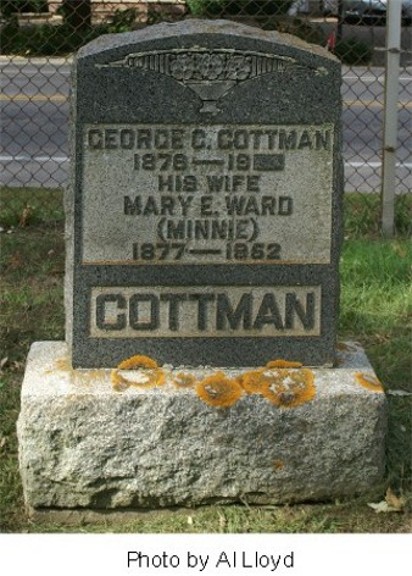
|
|
Research Notes
Establishing an
accurate timeline for the events that led to his skull fracture was
extremely difficult to determine as there were 4 distinctly different
versions of the event recorded as shown below.
The letter sent home to his wife was the
easiest to dispel as he had already been in hospital for some time when
the battalion entered the front line.
According to the dates in the letter, he was
still in hospital, however his file clearly indicates that he had been
discharged and posted to the 39th Reserve
Battalion at that time, although he was admitted later for the same
issue. The idea
that it happened in France at all was also dispelled as he was admitted
to hospital the same day the battalion landed in Boulogne and backed up
by the fact that there was no Victory Medal or 1914-15 Star issued. This leaves West Sandling
as the only place that it could have happened.
One account had it as an exploding bomb while
practicing, however I discounted this as the preponderance of evidence
indicates a dummy bomb and there were no shrapnel type injuries. This was early in the
battalion’s life and the habits of recording events were
still being developed. It
would also appear that there are medical records missing from the file.
|
|


